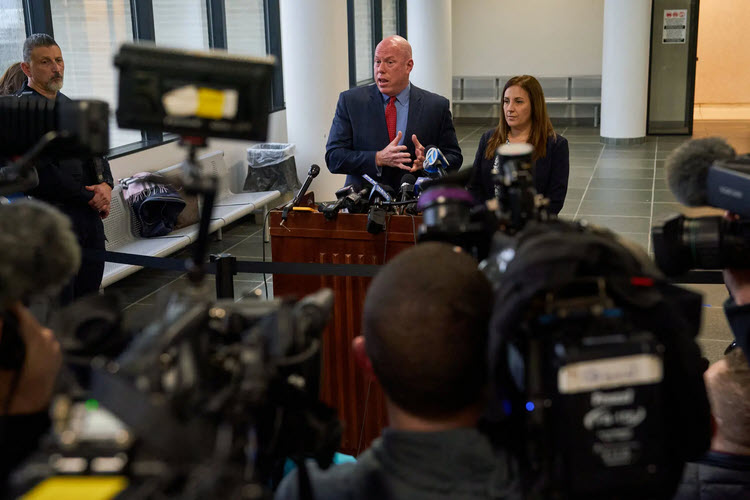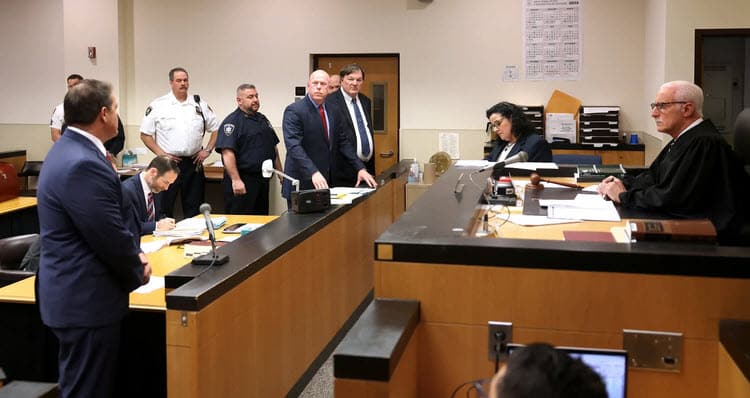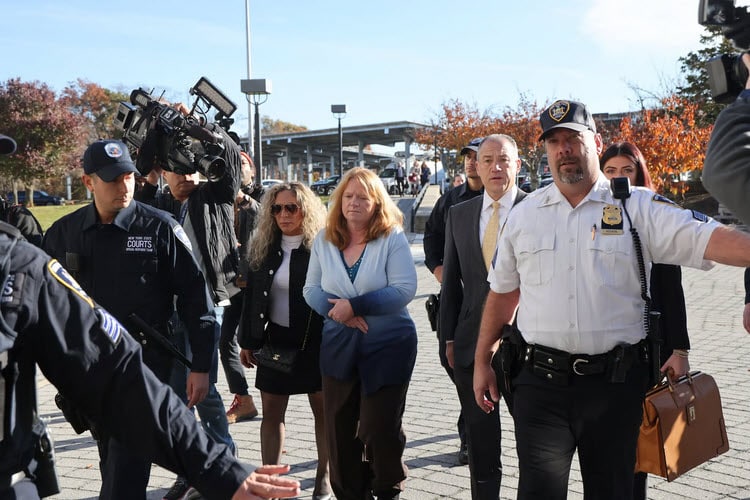
The lawyer for Rex Heuermann, the man accused in the case, said the early involvement of a notorious Long Island police chief may have tainted the investigation.

At an April court hearing, Michael Brown, Rex Heuermann’s lawyer, suggested that the real killer in the Gilgo case might have eluded arrest years ago when the investigation was being run by James Burke, a former Suffolk County police chief.Credit…Bing Guan for The New York Times
By Corey Kilgannon, New York Times
May 23, 2024
After Rex Heuermann was arrested last summer and then charged with murdering four women whose bodies were found in 2010 along Gilgo Beach on Long Island, prosecutors disclosed a barrage of details to support their case, including genetic evidence and sadistic porn sites they said Mr. Heuermann visited.
Now, with the trial still months away, the defense’s strategy is beginning to take shape. Mr. Heuermann’s lawyer, Michael J. Brown, has begun to float an alternate theory about the case: that the investigation into the murders was tainted years ago by the involvement of a now-disgraced Long Island police chief.
The chief, James Burke, who oversaw the investigation as head of the Suffolk County Police Department from 2012 to 2015, later became a symbol of police corruption and spent time in federal prison.
At a hearing last month following a procedural court appearance by Mr. Heuermann, Mr. Brown repeated his client’s claims of innocence. He also suggested that the real killer might have eluded arrest years ago when Mr. Burke was running the investigation.
Mr. Brown, a charismatic figure who arrives at court in a gleaming pickup truck, even suggested that Mr. Burke himself might have been involved in the four Gilgo killings, alluding to a fringe theory held by some followers of the case. Among the hundreds of leads turned over to him by prosecutors, Mr. Brown said, were “numerous” ones alluding to Mr. Burke’s involvement. Mr. Brown did not offer more details, and Mr. Burke is not a suspect in the case.
Mr. Brown, who has avoided doing interviews, has limited his public comments largely to damage control after court appearances.
After the hearing, Mr. Brown referred to reporting last year from The Washington Post, which suggested that before setting their sights on Mr. Heuermann, investigators in 2021 had homed in on another suspect, a retired police officer who lived near Mr. Heuermann, and planned to arrest the man. Tim Sini, the Suffolk County district attorney at the time, has disputed this.
By offering these various scenarios, Mr. Brown is “planting a seed, to the extent that people follow the media and hear these comments,” said Fred B. Klein, a former bureau chief for the Nassau County district attorney’s office.
Mr. Burke’s troubled tenure as the boss of the Gilgo case was among a host of problems during the first decade of the investigation, which stalled repeatedly as it become embroiled in county politics, corruption and criticism from victims’ families who said the case had been neglected because the woman who were killed worked as escorts.
Dredging all this up allows Mr. Brown to raise questions about how the evidence in the case, including the genetic material, was obtained and handled, said Bruce Barket, a prominent Long Island defense lawyer.
“By raising Burke, you’re kind of calling into question the whole case,” Mr. Barket said, adding: “Anytime you can bring James Burke’s name into things in Suffolk County, you can score points of some sort because everyone knows how corrupt he was.”
Mr. Burke’s lawyer, James O’Rourke, said that Mr. Brown was exploiting a “giant conspiracy theory” that falsely connected Mr. Burke to the Gilgo murders, when in fact there was not “a scintilla of fact linking Jimmy Burke to any of these crimes.”
“Jimmy Burke is a lot of things, and some of them are less than admirable, but he’s not a killer,” said Mr. O’Rourke, adding that as police chief, Mr. Burke was too far removed from direct oversight of the Gilgo investigation to have any effect on it.
As Mr. Brown defends Mr. Heuermann, 60, on the four murder charges, investigators are working to see if six other bodies found in the Gilgo Beach area in 2011 are also connected to him.
Last month, investigators used cadaver-sniffing dogs to scour a remote wooded section of the Long Island town of Manorville near where partial remains had been found more than 20 years ago that matched the partial remains of two victims discovered near Gilgo Beach in 2011, neither of whom have been linked to Mr. Heuermann. Officials would not say what prompted the search.
On Monday, investigators who had scoured Mr. Heuermann’s Massapequa Park house extensively last July returned to search it again with another warrant that was probably based on newly uncovered information, said Robert Macedonio, a lawyer for Mr. Heuermann’s wife, Asa Ellerup.
In the April court hearing, prosecutors updated the judge in the case, Timothy Mazzei, on their recent progress in turning over evidence to Mr. Brown. The amount of information is immense, including terabytes upon terabytes of autopsy reports, transcripts and exhibits from an earlier grand jury presentation, as well as nuclear DNA findings that prosecutors feel confident will secure Mr. Heuermann’s conviction.
Mr. Brown complained about the lack of evidence that had been turned over to him regarding Mr. Burke’s problematic leadership of the investigation. During that time, the chief became embroiled in a scandal that would lead to a 2016 conviction and a federal prison sentence for assaulting a handcuffed suspect at a police station and trying to cover it up.
After Mr. Burke’s release from prison in 2019, he was arrested again last year on charges that he had exposed himself and solicited sex from an undercover ranger at a Long Island park.

In the April court hearing, prosecutors updated the judge in the case, Timothy Mazzei, right, on their recent progress in turning over evidence to Mr. Brown, center.Credit…Pool photo by James Carbone
After the hearing, Mr. Brown called for the release of material gathered by the F.B.I. about Mr. Burke’s involvement in the Gilgo investigation, hoping the information would bolster his claim that the investigation was tainted by the former police chief’s stonewalling of the F.B.I. and his history of hiring prostitutes.
Mr. Brown called it “problematic for us that the chief of police who was running the investigation had this very checkered past and was involved in criminal activity.”
He also did not rule out the possibility of calling Mr. Burke as a witness during the trial.
At the hearing, the Suffolk County district attorney, Ray Tierney, said that Mr. Brown’s requests about the F.B.I. material were out of his office’s jurisdiction. A spokeswoman for Mr. Tierney declined to comment on any allegations regarding Mr. Burke.
Mr. Barket said Mr. Brown would also be likely to try to attack the prosecution’s reliance on genetic evidence. Mr. Brown, Mr. Barket said, would argue that DNA can be transferred between people, items and locations and that the genetic material gathered in the case does not point to Mr. Heuermann.
Mr. Brown has already belittled the case as hanging from a “strand of hair,” a reference to prosecutors’ claims that the DNA profile obtained from a male hair found on one of the four victims corresponds to his client.
Prosecutors say Mr. Heuermann is further implicated by hair strands belonging to his wife and daughter that were found on the victims. Mr. Heuermann’s wife and daughter have not been charged.
Asked last month about the genetic evidence, Mr. Brown said, “You’re talking about one strand of hair. If someone kills somebody, they’re going to leave just one strand of hair?”
Still, Mr. Barket said, the DNA material is only one of numerous pieces of evidence that prosecutors are attempting to fit together to create a convincing portrait of Mr. Heuermann as a killer.
“The defense might be able to chip away at a few of them, but it’s tough to knock out enough to raise reasonable doubt,” Mr. Barket said. “You can’t rebut everything and say it’s all wrong.”
One recent development in Mr. Brown’s favor is the return of Ms. Ellerup to her husband’s corner.

In March, Mr. Heuermann’s wife, Asa Ellerup, said her husband was “not capable” of committing the four murders he has been charged with.Credit…Hoo-Me.Com/Mediapunch, via Ipx
Days after his arrest, she seemed to be withdrawing support and filed for divorce. But in March, Mr. Macedonio issued a statement from her saying that her husband was “not capable” of murdering the four women and that she was giving him “the benefit of the doubt.”
She now regularly visits Mr. Heuermann in his Suffolk County jail and attends his hearings, often with a camera crew in tow for the lucrative documentary deal she has made. Mr. Macedonio said she planned on attending the trial.
“It’s a highly circumstantial case with no eyewitnesses and over 3,000 leads over the years,” he said. “So with all that out there, she wants to wait to see what comes out during the trial.”
https://www.nytimes.com/2024/05/23/nyregion/gilgo-beach-murders-police-chief.html
